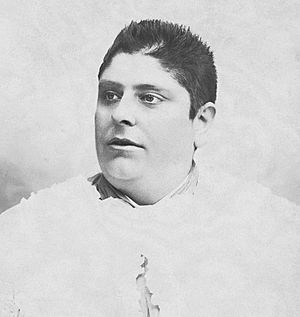Alessandro Moreschi facts for kids
Quick facts for kids
Alessandro Moreschi
|
|
|---|---|

Moreschi c. 1900
|
|
| Born | 11 November 1858 Monte Compatri, Latium, Papal States (now Latium, Italy)
|
| Died | 21 April 1922 (aged 63) Rome, Italy
|
| Alma mater | Scuola di San Salvatore in Lauro |
| Occupation | Opera singer |
Alessandro Moreschi (born November 11, 1858 – died April 21, 1922) was a very special Italian singer. He was known for his amazing voice in the late 1800s and early 1900s. He was one of the last famous singers of his kind.
Contents
Early Life and Training
Alessandro Moreschi was born on November 11, 1858. His family lived in a town called Monte Compatri, near Rome, in what was then the Papal States.
When he was about 12 years old, his singing talent was noticed. A man named Nazareno Rosati, who used to sing in the famous Sistine Chapel choir, brought Alessandro to Rome.
Alessandro became a student at the Scuola di San Salvatore in Lauro. There, he was taught by Gaetano Capocci. Capocci was a very important music director at the St John Lateran Basilica.
First Performances
In 1873, when Alessandro was just 15, he became the main soprano singer in the St John Lateran choir. A soprano is a singer with a very high voice.
He also sang as a soloist at fancy parties in Rome. People loved to hear him sing. His voice was so beautiful that he became known as l'Angelo di Roma, which means "The Angel of Rome."
In 1883, Alessandro sang a difficult solo part in a special music piece by Beethoven. This performance showed off his amazing voice. Soon after, he joined the famous Sistine Chapel Choir. He was the main soprano there for the next 30 years.
Singing in the Sistine Chapel
In the Sistine Chapel, Alessandro worked under Domenico Mustafà. Mustafà was also a great singer. He knew that Alessandro was very important for keeping old traditions alive. One of these was singing the famous Miserere by Gregorio Allegri during Holy Week. This piece needed a very high voice, and Alessandro was one of the few who could sing it.
Alessandro was a star, and sometimes he acted like one! After concerts, he would proudly walk through the crowd, showing off his long, white scarf.
Changes in Church Music
The Sistine Chapel Choir followed very old traditions. Alessandro became a leader among the solo singers. He also helped manage the choir's daily activities and rehearsals.
During this time, there were big changes happening in church music. A movement called Cecilianism wanted church music to go back to older, simpler styles. This was a challenge to the way the Sistine Chapel usually performed.
Alessandro saw these changes happening. He also sang for important events outside the church. On August 9, 1900, he sang at the funeral of the Italian king, Umberto I. This was a big deal because the Pope and the Italian government were not officially connected at that time.
Making Recordings
In 1902, Alessandro Moreschi made history. He made his first recordings in the Vatican for a company from London. He made more recordings in 1904. There are 17 recordings of his voice in total. These recordings are very special because they are the only ones of a famous singer of his type.
Alessandro officially retired from the Sistine choir in 1913. He had served for 30 years.
Later Life and Passing
After he retired, Alessandro Moreschi lived in an apartment in Rome, close to the Vatican. He passed away on April 21, 1922, at the age of 63. He might have died from pneumonia.
His funeral was a big event held in a church in Rome. Alessandro was buried in his family's tomb in the Cimitero del Verano, a large cemetery in Rome.
How He Looked and Acted
People described Alessandro Moreschi as being of medium or small height. He had a friendly face and no beard. His chest was wide and strong. When he spoke, his voice sounded clear and high, like a very high tenor. He seemed youthful and had lively conversations. People found him charming.
His Recordings
All of Alessandro Moreschi's recordings were made in Rome. They were done in two separate sessions for the Gramophone & Typewriter Company.
The first recordings were made on April 3 and 5, 1902. Eighteen recordings were made with the Sistine Chapel Choir members. Four of these were solos by Moreschi. The recording team set up their equipment in a grand room in the Vatican.
The second set of recordings was made in April 1904. Today, you can find these historic recordings on special CDs.
Images for kids
See also
 In Spanish: Alessandro Moreschi para niños
In Spanish: Alessandro Moreschi para niños



